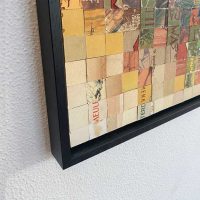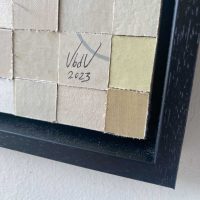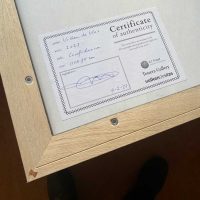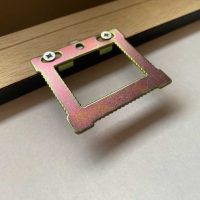FAQ handcrafted mosaics.
General information:
The tiles consist of old children’s book covers made of cardboard. These are glued to a panel of 12mm thickness that has a white coating on both sides.
Would you like to view a work? You are most welcome in my studio, or I will inform you about the location of the work. Galerie Waarkunst always has a number of works in its collection. You can also follow me on social media or via the newsletter for updates on exhibitions and fairs.
Are you interested in an available work? Please feel free to contact me, I will be happy to inform you.
The price of free work and commissioned work depends on the size, type of image and your choice for a possible frame.
As a guideline, you can roughly assume the indications below, incl. VAT, baking list and shipping within NL.
60x60cm – €1000
90x60cm – €1500
100x75cm – €2000
120x80cm – €2500
That’s certainly possible! I can have your purchase shipped insured with a reliable transport service or courier. I can make you an offer for this in consultation. Shipping within the Netherlands is free.
 As standard, a mosaic is framed in a black wooden frame. It is of course also possible to have a mosaic framed in a white or natural (wooden) frame, depending on your wishes. A frame with (museum) glass is also possible.
As standard, a mosaic is framed in a black wooden frame. It is of course also possible to have a mosaic framed in a white or natural (wooden) frame, depending on your wishes. A frame with (museum) glass is also possible.

 All mosaics are signed and provided with a certificate of authenticity on the back.
All mosaics are signed and provided with a certificate of authenticity on the back.
Commissioned mosaics:
The larger a mosaic, the better details can be expressed with the 25x25mm tiles. In addition, the composition is very important. For example, a close-up portrait offers more room for smaller details. For a striking portrait I usually end up with a size of at least 75cm on the short side, but if the photo lends itself to it, a smaller size of at least 60x60cm is sometimes also possible. Depending on your wishes and supplied image, I can propose a number of sketches on which you can base your choice.
Depending on the number of orders, the delivery time for a new mosaic is about 4 weeks. Do you have an earlier date in mind, for example in connection with a birthday or anniversary? Feel free to ask about the possibilities, maybe I can move and it will work sooner!
The best starting point for a strong mosaic is a light, clear photo. The 25mm tiles can only show details in a mosaic to a certain extent, so small elements such as earrings etc. are lost in the end result. If you are interested in placing an order, I can advise you without obligation on the basis of a number of photos that you propose.
In addition to photos, it is also possible to base a mosaic on other images such as a (children’s) drawing or illustration.
In addition to portraits, it is of course also possible to take other subjects as a starting point, such as landscapes, houses, animals or abstract forms. If you have an idea that you would like to realize, I can advise you without obligation.
Certainly! A mosaic can be realized from various materials. You can provide books yourself, but other paper or cardboard-like materials are also possible, such as labels, maps, fabric or (company) printed matter. I would love to explore your ideas with you!
Maintenance and use:
 Each mosaic is supplied as standard in a wooden frame with a hanging bracket. A single screw is sufficient for hanging on your wall/wall.
Each mosaic is supplied as standard in a wooden frame with a hanging bracket. A single screw is sufficient for hanging on your wall/wall.
A mosaic of 100x80cm weighs about 9 kg including a wooden frame.
Just like paint in a painting, there is a chance that the ink colors of the tiles will age/fade over the years under the influence of UV light (sun and daylight). Tiles in the mosaic will come from different book covers and can react differently to the influence of light. It is therefore preferable not to hang a mosaic in direct sunlight. You can illuminate your mosaic beautifully with LED daylight lamps that do not emit UV radiation.
Tessera mosaics are made from old recycled book covers, some nearly 100 years old. It may occasionally happen that over the years (after they have been incorporated into a mosaic) the top layer (print) of a tile curls up a bit at a corner. This is completely harmless and is part of the processing / recycling of old materials. You can easily fix this yourself by gluing the curled-up corner back on with a bit of transparent hobby glue or water-based paper glue.